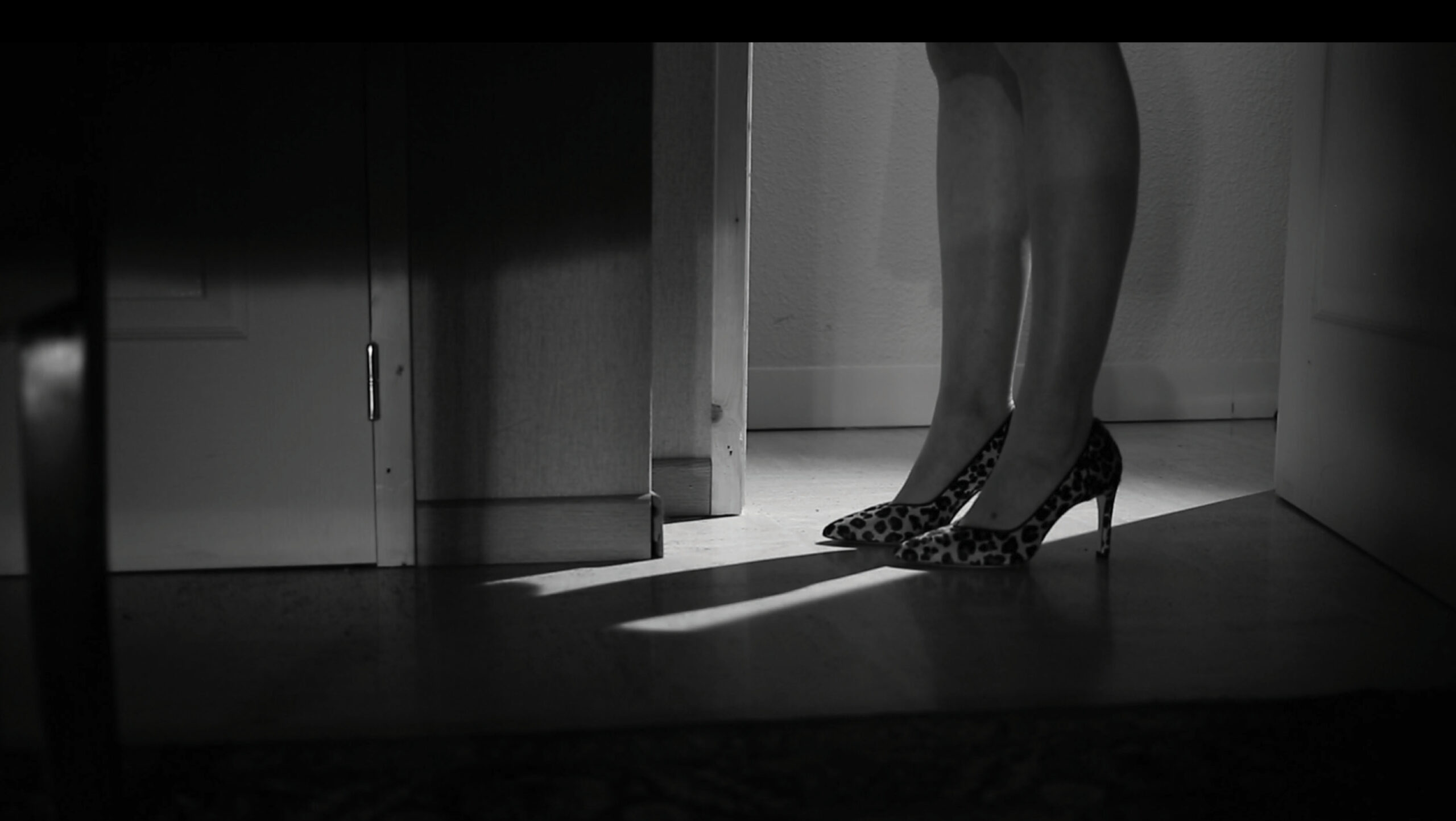Alexander Hancock reviews an independent neo-noir thriller as part of our Raindance 2020 coverage.
With its distorted shadows, suspenseful montages and unnerving high-angle shots, all cloaked in heavy black and white, you could be forgiven for thinking that The Woman in Leopard Shoes is a French noir thriller from the 1940s. That is, until you spot the protagonist using his iPhone as a flashlight, and you realise that Alexis Bruchon’s film is not from the war years, but rather a modern take on the beloved, and at times, polarising, genre. This feeling of déjà vu in no way feels like a copy, but instead illustrates the director’s appreciation for the time period’s distinct brand of morally corrupt figures clad in trench coats, vintage Pontiac streamliners, and kaleidoscopic visuals of moving silhouettes. Bruchon draws on these classic elements, yet manages to imbue the film with his own unique style, producing an effective blend of nostalgic cinema and innovative craft, creating a highly immersive tale of deceit and betrayal.
At the start of The Woman In Leopard Shoes, the protagonist is given a simple assignment: to steal a coveted box from a study, located in a secluded home. He is delivered these instructions as he stands in a remote forest, with a black hood over his head, so as to protect the anonymity of his employer who explains very little about the operation, but emphasises that time is a precious commodity in the thickening haze of his mission. Nothing is revealed about the identity of either character nor the reason behind their business. But while the protagonist’s task appears overly simple to begin with, this soon develops when his assignment enters murky waters upon a significant discovery that complicates matters far more. His mission reveals itself to be part of a much larger conspiracy, which proves to be more consequential than the mere retrieval of an object.
The beginning of the movie draws many parallels with the film noir genre, working through a checklist of tropes and motifs that harken back to a Hitchcockian thriller: the leading man driving as an eerie score plays, a dramatic sequence set in a shower, chiaroscuro lighting shrouding a character’s face in shades of black and white. However, as the film progresses, Bruchon introduces elements that subvert, or at least, challenge, our expectations of the “classic” film noir: juxtaposing static and hand-held shots, isolating the film to a single location, and, most obviously, using technology, including on-screen text messages as a vehicle driving the narrative. While Bruchon’s use of ambiguity helps to sustain a sense of narrative intrigue throughout the movie, some may feel frustrated by the central character’s lack of backstory and exposition. Questions of motivation and incentive can distract from the events of the film, as can the confusion surrounding the plot itself, given the shortage of dialogue to help explain the events on screen.
Film noir is an inherently divisive genre. This is in part because of the disagreements surrounding what actually constitutes a film noir, and whether it is a genre, or rather an amalgamation of stylistic choices – but more importantly, because of the intrinsic misogyny that seeps into the fabric of many of the films. Extensive literary criticism highlights how the women of film noir are very much indicative of the contemporary fears and concerns plaguing the early 1940s. Much like the colour palette of the genre, female characters in film noir are typically black and white: either elusive, dangerous narcissists, that exploit their sexuality to ensnare naive men, or angelic virgins that are emblematic of untarnished purity. The notorious femme fatale serves as a warning of women’s liberation and the danger of seduction, contrasted with the maternal, loving wife who represents a woman that understands her place under the patriarchy. A perfect dichotomy of good and bad, light and dark, pure and adulterated. Bruchon opts for a more modern interpretation of the genre, leaving behind the antiquated archetypes of evil seductresses and instead choosing to depict compelling and multi-faceted characters — a real testament to his directing and writing abilities, considering most of the characters’ faces are never revealed.
At times, watching The Woman in Leopard Shoes feels very much like an interactive experience, inviting the viewer into a detective-themed escape room to inspect and peruse the setting for clues and hints, lost keys and mysterious envelopes. For a film that virtually takes place in one setting, with very limited dialogue, the director makes effective use of sound design, flashbacks and extreme close-ups to establish an unsettling sense of foreboding that permeates the film throughout. The director’s inspired take on the genre sees him – for the most part – breaking away from the bonds of tradition, abandoning the archaic tropes and stereotypes that were endemic to film noir in the 40s and 50s, in exchange for a far more refreshing interpretation. The Woman in Leopard Shoes is clearly a passion project for Alexis Bruchon, and based on what we’ve seen with this film, we can expect even more gripping high-stakes thrillers in the future.
The Woman With Leopard Shoes will be available to view online for free as part of Raindance Film Festival. Use the following link:
https://cinema.raindance.org/film/the-woman-with-leopard-shoes/




